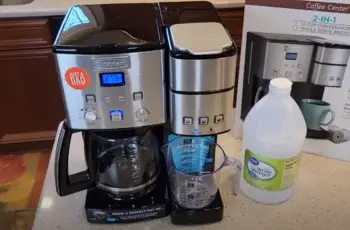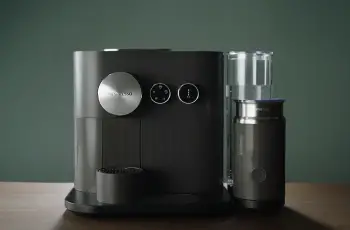Espresso is the preferred method of brewing coffee, whether in commercial settings or with home coffee devices. This technique requires forcing water through finely ground coffee under significant pressure. Achieving the ideal espresso mix is unattainable without the correct pressure level. Therefore, it’s crucial to grasp the pressure needs of a coffee machine.
What is the best bar pressure for a coffee machine? If you are new to coffee machines, you need to understand coffee machine pressure requirements. There is usually a lot of confusion around the bar pressure issue for coffee machines. Professional coffee machines need a 9-bar pressure to function at their best and deliver the best coffee. Home or small-scale coffee machines require a 15-bar pressure.
Here is everything you need to know about bar pressure in coffee machines.
What exactly is coffee machine bar pressure?
Bar in coffee machines is used as an abbreviation for ‘BAROS,’ a Greek word meaning weight. Traditionally, bar is used to measure atmospheric pressure, with the standard measurements at sea level defined as 1 bar, which is equal to 1.47 psi.
When it is said that a home coffee machine should have a 15-bar pressure, it simply means that the machine’s pump should create 15 x 1.47 psi. This can translate to 217 pressure psi. On the other hand, commercial coffee machines should have a 9-bar pressure, which is the same as 130 psi.
What is the best bar pressure for a coffee machine?
The recommended bar pressure for any coffee machine should be at least 9-bar. This has been the recommended pressure since the invention of the first espresso machine by Luigi Bezzerra. This was determined after Luigi discovered that pushing heated water (90 to 95 degrees) through finely-ground coffee as a 9-bar pressure produced the best brew quality. Anything above or below the 9-bar pressure pushes water too quickly or slowly, affecting the quality of the coffee. This is why 9-bar pressure is the standard pressure for all coffee machines in the market today.
Why do some domestic machines have a 15-bar pressure?
When compared to professional machines, coffee machines for home use are much smaller in size. Even though it comes with a 15-bar pressure at the pump, this drastically reduces before the water reaches the brew head. When a machine is set up correctly, the pressure reaches the 9-bar mark when the coffee and water meet, regardless of the pressure at the pump.
Advanced coffee machines come with overpressure valves (OPVs), which should be indicated in the machine specs. These valves regulate the pressure of the machine to ensure it reaches the optimal 9-bar pressure for perfect coffee brewing. If the pressure if under 9-bar, the valve does not open. This prompts the pressure to rise to the right range before the valve allows the water to flow through the coffee.
- Brews multiple k cup pod sizes: (6, 8, 10 ounces) the most popular k cup pod brew sizes; use the 6 ounces brew size to achieve the strongest brew
- Large 48 ounces water reservoir: Allows you to brew 6+ cups before having to refill, saving you time and simplifying your morning routine; The water reservoir is removable, making it easy to refill whenever you need to
- Descaling: An important part of cleaning your keurig brewer; this process helps to remove calcium deposits, or scale, that can build up inside a coffee maker over time
- Auto off: An auto off feature is easily programmed to turn off your coffee maker after it has been idle for two hours, helping to save energy. Removable Drip Tray
- Simple button controls: Just insert a pod, select your desired cup brew size, and brew a great tasting cup in under a minute
How to make perfect coffee following the pressure gauge?
To make the perfect coffee brew, many factors come into play, with the pressure of the coffee machine being one of the most important aspects. Learning how to use the pressure gauge to brew your coffee is the secret to delivering consistently tasty espresso.
All coffee machines come with a pressure gauge that indicates the amount of pressure applied during an extraction. The pressure of a coffee machine is not a variable you can adjust since it comes pre-set in the machine mechanics. Even so, you can use the pressure gauge to adjust a few aspects to get the perfect brew.
How pressure is created in a coffee machine?
Coffee machine pressure is created when there is a resistance of water flow from the machine to the cup. This resistance causes water to flow slowly through the ground coffee in the filter. The water path restriction causes a build up of pressure, causing the machine to work harder to pass the water through the coffee bed. When pressure is at 9-bar, this shows that complete extraction of coffee will be reached. In turn, this ensures that the coffee tastes better.
Too much pressure
When your machine pressure remains above 9-bar, it means that the machine is working too hard to ensure water passes through the coffee bed. This will cause the extraction process to take longer (over-extraction), resulting in acidic, bitter-tasting coffee.
To fix this issue:
- Change the grinder settings to a coarser capability setting
- Reduce the amount of coffee in the filter
- Tamp using less pressure
Coffee machine pressure too low
If the pressure gauge reads a pressure lower than 9-bar, this means that water if running through the coffee bed too fast (under-extraction). This results in a weak expresso that has a sour taste. You can fix this by:
- Adjusting the grinder to a finer setting
- Increase the amount of coffee in the filter
- Tamp using more pressure.
Brewing the perfect espresso is about controlling variables that affect the pressure of the coffee machine. By understating the relation between the coffee grind, tamping, or amount of coffee on the pressure, you are better placed to use the pressure gauge to brew the perfect espressos.
Troubleshooting coffee machine pressure problems
An espresso machine in good condition will always push at least 9-bar pressure to brew. When this starts to drop, it is usually an indication of an issue with the pressure pump.
Vibrations pumps in coffee machines are some of the parts that can last years without needing replacements. After 4 to 5 years of service, some pumps start to fail. The failure of a pressure pump shows when you realize there is a change in the pitch of your coffee, and you find yourself adjusting to coarser coffee grinds.
Conclusion
It is possible to brew the perfect coffee cup at home with an understanding of bar pressure and how it affects the quality of coffee. Today, numerous affordable home coffee machines can be used to deliver the best espresso. With the increased interest in home brewing, life has become easier for coffee lovers, thanks to the availability of home-based coffee machines, including the portable variations. With this guide, there is no reason not to brew the best coffee from home. Read more about our nitro cold brew maker.


